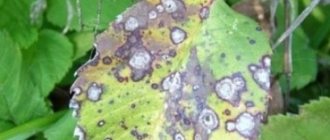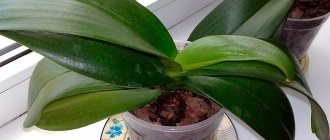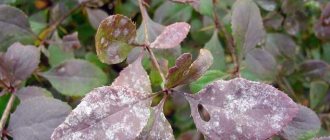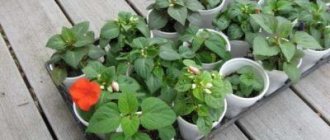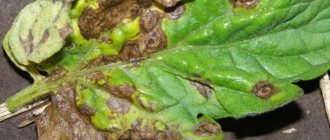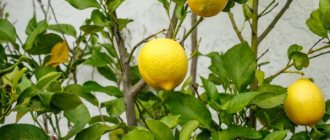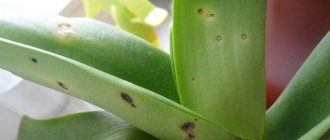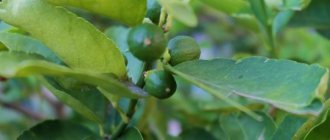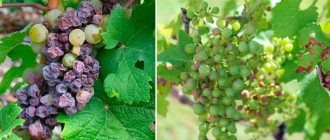Causes of homemade lemon diseases
Various diseases negatively affect the appearance of the plant and fruiting. Lemons are most often affected by diseases and pests:
- weakened by other diseases;
- for which proper care has not been established (watering, pruning);
Indoor lemon
- kept in unsuitable conditions (improper lighting, drafts, poor soil, poor temperature conditions).
Viruses, bacteria or pests may appear:
- from poorly treated soil,
- from a diseased cutting when grafting,
- while airing the room (happens extremely rarely),
- from sick indoor plants nearby.
Many lemon diseases can be cured, but there are also diseases that cannot be cured and the plant must be disposed of.
Viral diseases
Diseases caused by viruses are the most dangerous for citrus fruits. To determine which virus caused the disease, special studies are needed, which are not always possible.
Scientists know at least 280 types of viruses that can cause citrus disease.
The main symptoms of such diseases:
- the plant slows down;
- the color of the leaves fades;
- the shape of the foliage is deformed;
- shoots become bent.
Related article:
I fight a bear like this...
Viruses can be transmitted by pests that fly into the house, bouquets of flowers, or newly purchased new flowers.
Such diseases cannot be treated, so citrus fruits affected by the virus are destroyed.
Why do lemon leaves turn yellow?
Gooseberry diseases and their treatment
The leaves of indoor lemons turn yellow because:
- Incorrect lighting was chosen (direct rays of the sun provoke the appearance of burns, excessive shading, especially in the cold season, does not allow the plant to fully develop).
Lemon with yellowing leaves
- Insufficient or excessive watering, which are equally dangerous for lemon.
- Violation of the usual temperature regime causes stress in the plant, which leads to negative consequences. Lemons develop well in the temperature range of 14-25 C0, but 20 C0 is ideal for them. During ventilation (especially in autumn or winter), it is recommended to remove the lemon from the room to avoid sudden temperature changes. Central heating radiators or other heating devices should not be in the immediate vicinity of the pot.
- Increased or decreased level of humidity in the room (optimally from 60% to 70%).
- Irrational or irregular feeding. Lemon needs nutrients, but too much of them is not good for your pet.
How it is used in health care
Due to its properties, lemon is quite successfully used in cosmetology as a means to cleanse and lighten the skin. It is also rightfully considered one of the best bactericidal agents, as it destroys about 12 types of different bacteria. A drink made from lemon removes toxins from the body, restores digestion processes and relieves headaches. It is good as a diuretic; it is used to treat the throat and respiratory tract.
sour but healthy fruit
Since ancient times, folk medicine in different countries has kept various recipes for using lemon to cure malaria, dropsy, scurvy, jaundice, hemorrhoids, pulmonary tuberculosis, gout and other diseases. Most often, it is recommended to drink diluted lemon juice, diluting it with hot water 1:2. In this form, it helps with gastrointestinal diseases, fever, urolithiasis, hemorrhoids, atherosclerosis and metabolic disorders, if you drink it 2 or 3 times a day.
In ancient times, Avicenna advised women to eat lemons during pregnancy, because in this way they could cope with toxicosis.
How to use lemon so that it is tasty and healthy?
In cooking, it is useful to season vegetable salads with lemon juice; There is no need to add salt to them. As flavoring additives, the fruit or lemon zest is added to various culinary products and desserts. The strong aroma of citrus is used in aromatherapy; it tones, improves mood and gives vigor to a person. Essential oil is used to disinfect and freshen indoor air.
Losing weight with lemon is a pleasure, and it can only cause harm if you overeat it. It reduces the desire to snack frequently if you eat a little of it. Ayurveda claims that if you eat only one lemon a day, good health is ensured.
Lemon leaf chlorosis
Diseases of clematis and their treatment - what causes flowers
Plant chlorosis is a disruption of the process of chlorophyll formation in leaves. The main sign of the disease is yellowed leaf blades and green veins.
Leaf chlorosis
The main cause of the disease is a lack of iron and magnesium.
Ways to combat chlorosis:
- Transplanting the plant into new soil and a larger pot;
- Spraying the leaves with Ferovit solution (1.5 ml per 1 liter of water);
- Fertilizing with magnesium sulfate;
- Washing the soil in the pot (water the lemon with warm water for 30 minutes until clear liquid flows out of the drainage holes). This improves the soil structure and its breathability. 30 days after the procedure, the plant is fed.
Diagnosis of lemon diseases and pests based on characteristic features
In the fight against diseases, it is important to accurately recognize and diagnose them. Sometimes this is not entirely simple and requires certain knowledge and experience.
Problems with leaves
The main indicator of the health of a lemon is its leaves.
Lemon leaves are falling
Since lemon is an evergreen plant, seasonal leaf fall is not typical for it. As a rule, this is a reaction to various stressful situations:
- Lack of light. In winter, lemon requires additional lighting to extend daylight hours to 12–14 hours. It is better to use energy-efficient fluorescent lamps that do not heat or dehumidify the air.
- The air is too dry and hot. Do not place pots of lemons near heating appliances. To humidify the air, use special humidifiers or place wide containers of water near the plants.
- Excess or deficiency of moisture. Soil moisture should be constant and moderate. Deviations in any direction will lead to falling or yellowing of the leaves. Lemon should be watered when the soil dries to a depth of no more than 2 cm.
- Root rotting (more on this problem below).
- Nutritional deficiency due to soil depletion. The plant constantly needs both basic elements (nitrogen, phosphorus and potassium) and microelements. A lack of any substance first leads to a change in the shape and (or) color of the leaves, and then to their falling off. Therefore, fertilizing should be done regularly at intervals of 7–10 days.
- Sudden temperature change. The plant was moved from cold to warm or vice versa - the lemon does not like this and immediately drops its leaves. If movement is necessary, the temperature increase/decrease should be smooth.
- Cold in the room where the tree overwinters. In winter, lemon needs cool temperatures, preferably between 12–16°C; if it drops below 10°C, it is stressful and causes leaves to fall off.
Lemon leaves fall off for various reasons.
Video: how to help a lemon if its leaves are falling
The tips of the leaves dry out and/or turn black.
The causes of drying leaf tips are:
- The air is too dry.
- Very high or low air temperature.
- Using tap water for irrigation. It contains chlorine, fluorine, and may be too harsh. You should water the lemon with rain, melt, filtered or bottled water. If you still have to use tap water, then it should first be settled for 3-5 days.
- Heavily compacted soil in a pot.
- Deficiency or excess of moisture.
The tips of lemon leaves dry out due to dry air, dense soil, and lack of moisture.
The leaves are wrinkled
Lemon leaves begin to wrinkle when there is a lack of potassium. If you do not feed the plant in time, this will lead to marginal leaf burns, tissue death, then drying out and death of branches, and a reduction in the crown. To eliminate the problem, the plant is watered at the root with solutions of potassium-containing fertilizers (potassium sulfate, potassium monophosphate) at the rate of 5 g per 1 liter of water. Additionally, foliar feeding is carried out by spraying the crown with the same solution, but at half the concentration. The procedure is repeated after 7-10 days.
Lemon leaves shrink due to potassium deficiency
Small wavy leaves
Shredding of young leaves can occur due to a lack of nitrogen and (or) phosphorus. If in the first case the leaves turn yellow, in case of a lack of phosphorus they acquire a dark green, bluish, dull color. If there is a lack of nitrogen, the plant will recover quite quickly after adding a sufficient amount of urea or ammonium nitrate (2-3 g per 1 liter of water). And in case of phosphorus deficiency in a plant at an early age with poorly developed roots, it is almost impossible to eliminate the negative impact of this deficiency by abundant watering with a fertilizer solution. Adult plants will recover quite normally after applying a superphosphate solution at the root in an amount of 5 g per 1 liter of water.
Superphosphate is very difficult to dissolve, so first it should be dissolved in a small amount of boiling water, and then the amount of water should be adjusted to the required volume.
Leaves become smaller and become wavy due to lack of nitrogen and phosphorus
Warts on lemon leaves
This symptom indicates that the lemon is likely infected with scab.
The leaves are cracking
With a lack of calcium, the young leaves at the ends of the shoots first lighten, curl downward, and the leaf blade often breaks at the bend. Then the tops and edges die and the leaves fall off. In this case, you need to add slaked lime (fluff) or ground chalk. But this should be done carefully, since excess calcium is also harmful. It is better to first measure the acidity of the soil using litmus paper. If the pH level is below 5.0, then take 1 tsp. with a heap of fluff (or chalk), dissolve in water and water the plant. Then measure the acidity of the water flowing from the drainage holes, repeating the procedure if necessary. As a result, the acidity should be at pH 6-6.5.
The leaves are curling
This common problem can have the following causes:
- Lack of moisture, too infrequent watering and spraying. In summer, this should be done daily, but without allowing the soil to become waterlogged.
- Lack of fresh air. With the onset of stable heat, the plant should be taken outside, but it should be placed in places without drafts and protected from direct rays of the sun.
- Boron deficiency. In this case, young shoots and leaves curl up, as with a lack of moisture, but after watering the situation does not change. The plant should be fed with complex fertilizers or a 0.2% solution of boric acid (2 g per 1 liter of water).
- Copper deficiency also causes lemon leaves to curl, but in this case it curls into an arch. Foliar feeding with a 0.5% solution of copper sulfate will solve the problem
- Attack of aphids or mites.
If the lemon leaves are curled into an arc, they should be sprayed with a 1% solution of copper sulfate
Leaves are sticky
The sticky coating on the leaves is a sugar syrup released from them when overwatered. In this case, it is easy to get rid of the phenomenon - you just need to normalize the level of moisture in the plant. In addition, the sweetish sticky coating may be the secretions of pests - aphids or scale insects.
The leaves are turning yellow
This common phenomenon can have many causes:
- Nutrient deficiency. To avoid this, you should regularly feed the lemon with complex fertilizers.
- Violations of heat and humidity conditions.
- Insufficient lighting.
- Root damage, root rot.
- Chlorosis is a disease caused by a deficiency of certain elements, most often iron.
- Anthracnose is a fungal disease.
Lemon leaves turn yellow due to disease, poor lighting, lack of nutrients
More details about this issue can be found here.
Pale leaves
Lightening of the leaves is most often caused by poor lighting, so you should not forget about installing artificial lighting for the winter, as described above. Another common cause is manganese deficiency. To make sure of this, you need to spray the leaves with a weak pink solution of potassium permanganate (potassium permanganate) - if after a week the leaves darken, then the diagnosis was correct. Also, pale leaves can be a sign of chlorosis.
A common cause of pale leaves is lack of light.
Black dots
First you need to take a closer look. These spots may be harmful insects such as aphids or scale insects. Sooty fungus can also settle on the leaves.
Brown spots
Most often, brown spots appear as a result of a lack of phosphorus. Then it is necessary to feed the plant with phosphorus in the same way as in the case of crushing leaves. This phenomenon may also be a sign of lemon infection with phyllostictosis or citrus cancer.
White spots
White spots appear in the following cases:
- use of cold water for irrigation and spraying;
- the result of a burn from direct sunlight;
- powdery mildew infection;
- mealybug infestation.
Diseases, pests, cold water and burns can cause white spots to appear on the leaves of the plant.
Problems with fruiting
There are times when a lemon bush seems to grow and develop normally, but does not bear fruit. There may be several reasons for this.
Lemon doesn't bloom
Many gardeners in their reviews say that lemons grown from seeds do not bloom for many years. The problem is often solved by grafting a cutting or bud from a fruit-bearing plant into the crown of such a lemon. Some sources report cases where rooted cuttings from non-fruiting lemons bloom the very next year. And, of course, a lemon (even one planted with a grafted seedling from a nursery) will not bloom if the rules of its agricultural technology are not followed:
- Inappropriate soil composition.
- Failure to comply with heat and humidity conditions.
- Sudden changes in temperature and its non-compliance with the required parameters. The most abundant flowering is observed at a temperature of 18°C.
- Nutritional imbalance.
- Lack of lighting.
Video: an original way to make a lemon bloom
Lemon blooms but does not bear fruit
This happens in the following cases:
- The room is too hot and dry.
- Drafts.
- Poor pollination. It should be done manually by winding cotton wool around a match, transferring pollen from flower to flower.
- Insufficient nutrition - as a result, the ovaries fall off.
- The deadline for transplanting into a new pot has passed; the roots have become crowded. Young plants should be replanted up to three times a year, 3-4 year old plants - once a year, at the age of 5 years and older - once every 2-3 years.
- Too much flowering. The plant does not have enough strength and nutrition to produce a large number of flowers and it sheds its ovaries. It is necessary to normalize at the flowering stage, leaving one bud for 10-15 leaves.
- During flowering, you cannot move the plant from room to room, or rotate it more than 10° and more than once every ten days. As a result of such actions, the lemon may lose flowers or ovaries.
Sometimes lemon blossoms do not produce fruits.
Lemon fruits fall
If a gardener has grown fruits of normal size on his lemon, this means that the care was correct and no mistakes were made. But if suddenly large lemons began to fall off, then, obviously, the plant was subjected to some kind of stress (drafts, temperature changes, turning the pot or moving it, etc.).
Sometimes the ovaries do not have time to ripen and fall off
Other problems
And about some other problems.
The branches of the lemon are drying up
The reasons for this phenomenon, like many other troubles, can be violations of agricultural technology. Most often this is a consequence of moisture deficiency, as well as its excess. In addition, the branches may dry out if the lemon is damaged by spider mites. If everything is in order with agricultural technology and pests, but the branches of the lemon still dry out in winter, then perhaps this indicates the acclimatization of the plant. In this case, in the spring, all dried shoots should be removed, and new ones will grow in their place.
Drying lemon branches signal a deficiency or lack of moisture, disease, or acclimatization of the plant.
The roots are rotting
Most often this occurs due to excessive watering, as well as improper selection of the pot and (or) lack of drainage. If the pot is too large, the soil will become sour, causing root rot. This can be determined by the shedding of leaves. If the soil remains moist for a long time even in the absence of watering and dry air in the room, then this indicates that it is urgent to check the condition of the root system:
- To do this, you need to remove the plant from the pot with a lump of earth and inspect the roots, after first removing all the substrate from them and rinsing them with water.
If the roots rot, you need to remove the plant from the pot.
- Rotten roots should be cut back to healthy tissue, the remaining roots should be treated with a weak solution of potassium permanganate by dipping the roots into it for several minutes and sprinkle the sections with charcoal.
- If pruning has significantly reduced the volume of the root system, then choose a smaller pot for planting.
If the root system had to be reduced, then take a smaller pot
- After planting, the lemon is watered generously and sprayed with warm water.
- You cannot feed the plant for a month until it has completely taken root.
Why do lemon leaves curl?
One of the common diseases of homemade lemons is leaf curl.
Phlox diseases and their treatment: why leaves curl
Causes of the disease:
- 1) Violation of the rules of care (most often improper moistening of the soil and air).
- 2) Lack of mineral fertilizers (deficiency of calcium, boron or copper in the soil).
- 3) Lack of fresh air.
- 4) Damage to the plant by various pests (both on the crown of the tree and on the root system).
Important! Mineral fertilizers are applied very carefully, since their overdose has a negative effect on the plant.
Causes of lemon leaves falling off
The question “why does a lemon drop its leaves, what should I do” worries many plant growers. A common cause of homemade lemons dropping leaves is some kind of viral or fungal disease:
- Leaf mosaic (leaves change their shape, dark or light strokes appear on them, reminiscent of a mosaic, the plant stops growing). It is impossible to treat a diseased lemongrass; you can only prolong the life of the plant by regularly feeding and properly caring for it. Experts recommend destroying such a lemon so that the disease does not spread to other plants.
- Cancer of citrus plants (in the initial stages, the leaves and fruits become covered with brown spots, later the lemongrass takes on ugly shapes, the foliage falls off, and the tree dies). It will not be possible to revive a diseased tree, but to prevent cancer, it is recommended to spray the lemon with liquid copper fungicides.
- Tristeza (one of the reasons why a lemon sheds its leaves; in addition, the branches and bark gradually die off, and the tree dies). The disease is incurable and most often affects weakened plants.
- Anthracnose (leaves turn yellow and fall off, thin branches die, the tree may drop its buds, red spots appear on the fruits). Treatment: cut off dried branches, treat the plant three times with Fitosporin, a 1% solution of Bordeaux mixture is also suitable.
- Malsecco (leaves fall off, shoots from the tops begin to dry out, branches turn red when cut). The cause is a lack of lighting; from October to April, the plant needs lighting to increase daylight hours. Treatment with drugs is impossible. If normalizing the light regime does not help, then the plant should be disposed of.
- If affected by root rot, the lemon may also shed its leaves. If for this reason the leaves of a lemon fall off, then you know what to do: dig up the plant, wash and inspect the root system, and remove rotten roots. The lemon is planted in another pot in disinfected soil. For 12-14 days, do not water the plant, but only spray it with warm water and wipe the leaves with a damp sponge.
Treatment of infectious diseases
The main infectious diseases of lemon are gommosis and root rot.
2.1. Infectious gommosis (gum discharge)
Hommosis, as already mentioned, can appear for various reasons, including due to infection of the tree through mechanical wounds. When the pathogen gets inside the plant, brown-red longitudinal spots appear on its trunk and branches, which crack. From the cracks a sticky substance is released - gum, which when hardened resembles a resin. In places where gum is growing, the bark dies, the leaves do not receive nutrition due to blockage of blood vessels, turn yellow and fly off.
Hommosis is treated by pruning diseased branches (with a ten-centimeter grasp of healthy bark), stripping the affected areas on the trunk, followed by disinfection with a 3% solution of copper sulfate. Wounds are treated repeatedly until the flow stops.
2.2. Root rot
The disease manifests itself as a massive shedding of foliage, often with no signs of any damage. Sometimes, when you have root rot, you may notice spots on the trunk of a tree with a dirty substance oozing from them. The disease occurs due to waterlogging of the soil, as well as when the root system is infected through wounds received, for example, when replanting a plant or being damaged by pests.
Having discovered rot, the affected roots are removed completely or partially using a sharp knife or pruning shears. The cut sites are treated with activated or crushed charcoal and rooting stimulants. Old soil must be replaced with new soil. After transplanting, it is not recommended to water the lemon for 6-7 days to avoid re-rotting of the roots. Instead of watering, wipe the leaves with a damp cloth. During this period, it is recommended to provide the tree with diffused lighting for at least 12 hours. If the daylight hours are short, the plant is given additional illumination using fluorescent or phytolamps.
Sticky coating on lemon leaves
Sticky plaque not only spoils the appearance of the tree, but also inhibits its development.
Sticky spots on leaves
Reasons for the appearance of a sticky layer:
- inadequate care;
- excessive watering for a long time;
- the plant was attacked by scale insects;
- Aphids appeared on the lemon.
The first 2 factors are easily eliminated after studying the relevant information on proper plant care. Scale insects and aphids are pests that are difficult to control, but quite possible.
Note! Sticky golden resin on reddish-brown spots and cracks on the trunk and branches of a tree is a sign of homosis, the causes of which lie in a lack of potassium and phosphorus, an overdose of nitrogen or poor soil.
Preventive measures
To prevent the appearance of diseases and pests on this exotic plant, the gardener is required not only to comply with agrotechnical rules, but also to provide competent care. First of all, such measures should be aimed at increasing the plant’s immunity and its resistance to infection.
It is possible to prevent chlorosis (imbalance in the distribution of chlorophyll) and activate the growth and development of the plant by using the following composition in the nutrition of an indoor tree:
- ammonium nitrate - 15 g;
- iron sulfate - 3 g;
- boric acid - 5 g;
- Potassium sulfate - 15 g.
The dry mixture is dissolved in 10 liters of water. Lemons are watered with a nutrient solution no more than once every 5 months.
This composition protects indoor citrus fruits from fungal, viral and infectious diseases. It gently stimulates the healthy development of plants.
In the process of growing lemons, it is important:
- regularly inspect for diseases and parasites;
- provide the culture with timely care and the necessary conditions of maintenance;
- Carry out regular moistening of the crown: irrigate daily, shower once a month;
- Every month, for disinfection purposes, treat the crown with soap foam.
Fighting yellow spots on lemon leaves
Lack of lighting, low air humidity, inadequate watering, sudden temperature changes and poor nutrition can cause yellow spots to appear on the leaves of homemade lemons. The same symptoms can be observed in some diseases:
- Scab or wart is a fungal infection of a plant, the main symptom of which is yellow spots on the leaves, gradually degenerating into pink-gray warts (growths). Orange spots appear on the fruits. Warts gradually spread throughout the plant, destroy the fruits, and can lead to the death of the tree. Treatment: treatment of the crown with a 1% solution of Bordeaux mixture, removal of affected branches, fruits and leaves.
- Infection with dark brown spot (the appearance of irregularly shaped yellow spots on leaves) is incurable. The diseased plant must be destroyed to avoid spreading the disease to others.
- With phyllostictosis, brown specks with rims appear on the lower leaves.
- Late blight is characterized by swelling of the bark and oily spots on the foliage.
Phyllosticosis and late blight can be cured with fungicidal drugs.
Drying tips of leaves and white spots on them
The tips of the leaves may dry out when:
- unsuitable microclimate;
- unbalanced lighting;
- mineral starvation;
- incorrectly selected soil for planting;
- infection by parasites.
Lemon leaves covered with a white coating indicate the appearance of a whitefly butterfly.
Whitefly butterfly
Detecting a parasite is easy:
- after shaking the branches, the butterflies take off;
- grayish-white formations resembling mold appear on the leaves and shoots;
- affected leaves curl, turn yellow and dry out.
Ways to control insects:
- a few butterflies are destroyed by washing the leaves with gauze soaked in a soap solution;
- Sticky fly strips are hung near the tree;
- spray the plant several times with a sweet solution (2 tablespoons of sugar dissolved in a glass of water);
- a large number of insects can only be defeated with the help of special chemicals.
Major pests of citrus fruits
Even at home, various pests can appear on citrus trees. The main enemies of these plants:
- aphid;
- mealybugs;
- scale insects;
- spider mites, etc.
Scale insects on the stem of citrus fruits
This is interesting! How to fight aphids
To notice the appearance of pests in time, you should regularly inspect the foliage of citrus fruits. If there are few insects, then you can simply pick them off and destroy them immediately. When the insects have not multiplied much, you can cope with them using folk remedies:
- treat the foliage with onion (or garlic) infusion: chop the head of garlic, pour a liter of boiling water and leave for 24 hours;
- you can spray citrus fruits with tansy infusion (35 g of flowers per 200 mg of boiling water);
- sprinkle the foliage with tobacco dust.
Related article:
5 effective ways to help save grapes from wasps and bees
If there are too many insects, then you have to spray the plants with insecticides. It is very dangerous to use such drugs at home. To avoid inhaling toxic fumes from such a solution, it is necessary to use personal protective equipment during processing.
The most effective chemicals in pest control are:
- Aktara;
- Aktellik;
- Akarin;
- Fitoverm;
- Iskra-M.
Why doesn't lemon bear fruit?
Not all lemon trees bear fruit. For many owners, this is simply a beautiful decorative decoration for their home. Why lemon does not bear fruit, the main reasons:
- 1) the plant grew from a seed and was not grafted;
- 2) the tree is not grafted correctly;
- 3) violation of comfortable living conditions (temperature changes and low humidity);
lemon blossom
- 4) there are too many flowers and fruits on the tree (experts advise removing excess ovaries, following the rule: “10 leaves - 1 flower”);
- 5) untimely fertilizing (forces the lemon to lose color);
- 6) the plant is sick or infected with parasites.
What to do to make fruit appear on a lemon:
- Provide appropriate conditions for full growth and development.
- Fertilize regularly (in spring and summer 2 times a month, in autumn and winter - monthly).
- Graft the plant correctly (graft a strong tree whose bark is well separated from the wood). For the operation, use a clean and very sharp knife. To achieve the best possible alignment of the branch and petiole, the grafting site is tied tightly and tightly. The result will be judged after 3 weeks.
- Cure diseases and get rid of pests.
- Form the crown so that by the age of three it consists of 7 main branches (at the same time, try not to constantly shorten the tips of thin branches, since it is on them that flowers appear).
- The procedure of tightening the branches is carried out. To do this, in the spring they are tied together with soft wire to concentrate nutritional reserves in them for the next year.
Important! Under optimal conditions, the lemon will bloom 2-3 years after grafting.
Harmful insects for indoor lemon
Aphid
Homemade lemon diseases - causes and treatment
The main pest of citrus fruits is aphids. It destroys the leaves of the plant, then spreads to the branches of the tree. At the same time, aphids select the youngest and most tender leaves. What does the pest look like?
Aphid
This insect is small in size and has a light green color. The pest first attacks the inside of the leaves, which is why it is so difficult to notice at the early stage of infection. Then the insect takes over the entire plant along the branch. The first sign of an aphid infestation is curling of the leaves of your homemade lemon. The insect can get onto the citrus from another indoor plant, for example, fuchsia.
This culture is a favorite delicacy of aphids. You can harm your lemon by bringing wildflowers home. The pest can hide in the soil, and different crops suffer from it. Therefore, if you take untested soil after other plants or even another lemon, you risk completely destroying your indoor tree.
However, you should not immediately give up on the plant. The success of the fight depends on how quickly you identify the disease. If the pest has not managed to spread far, then it will be enough to cut off the infected branches and crush the pests.
Then it is recommended to apply complex fertilizer to increase the plant’s immunity. If there are a lot of aphids, you will have to use insecticides. The most popular aphid poison is diazinon.
Garlic infusion
Many gardeners use traditional methods. For example, an infusion of garlic helps against pests. To prepare it, use eight heads of garlic. They should first be cleaned and ground. Mix the finished mixture with water in a ten-liter bucket and leave for one day.
The infusion will be ready after you express it. If the aphids appeared due to poor-quality soil, then the soil will need to be replaced. Before this you need to prepare the plant. Place the lemon in a contact insecticide solution or garlic infusion. However, this time the concentration of the drug should be half as much as when fighting aphids.
Shchitovka
Another pest of homemade lemons is the scale insect.
It appears on citrus at the larval stage. The adult insect is motionless. It is attached to the underside of the leaf and covered with a special hard coating that will protect the insect from all sorts of dangers. If there are a lot of parasites, they will move to the front part of the leaf. Due to the influence of the pest, the lemon begins to weaken and dry out.
In this state, it cannot resist bacterial and viral diseases. However, there is control for this insect too. As with aphids, garlic water, insecticides, and a soap solution work well. The soap infusion is prepared as follows: dilute two tablespoons of liquid soap in a liter of water. Then treat the infected leaves with this preparation. After sixty minutes, thoroughly rinse the soap from the lemon. It is recommended to repeat the procedure after two or three days.
Spider mite
Spider mite
An ordinary spider mite can also destroy a plant. He is also not averse to eating young citrus leaves. The main sign of the pest is the characteristic cobwebs on the leaves of the plant. Very often, spider mites appear on crops growing in dry air conditions.
Spider mites are afraid of moisture. To combat ticks, use a one percent solution of boric acid. Most often, one spray is enough to kill the tick. However, if the tick does not give up, then repeat the procedure four or five times. An interesting fact is that pest control is equal to the prevention procedure against viral diseases.
